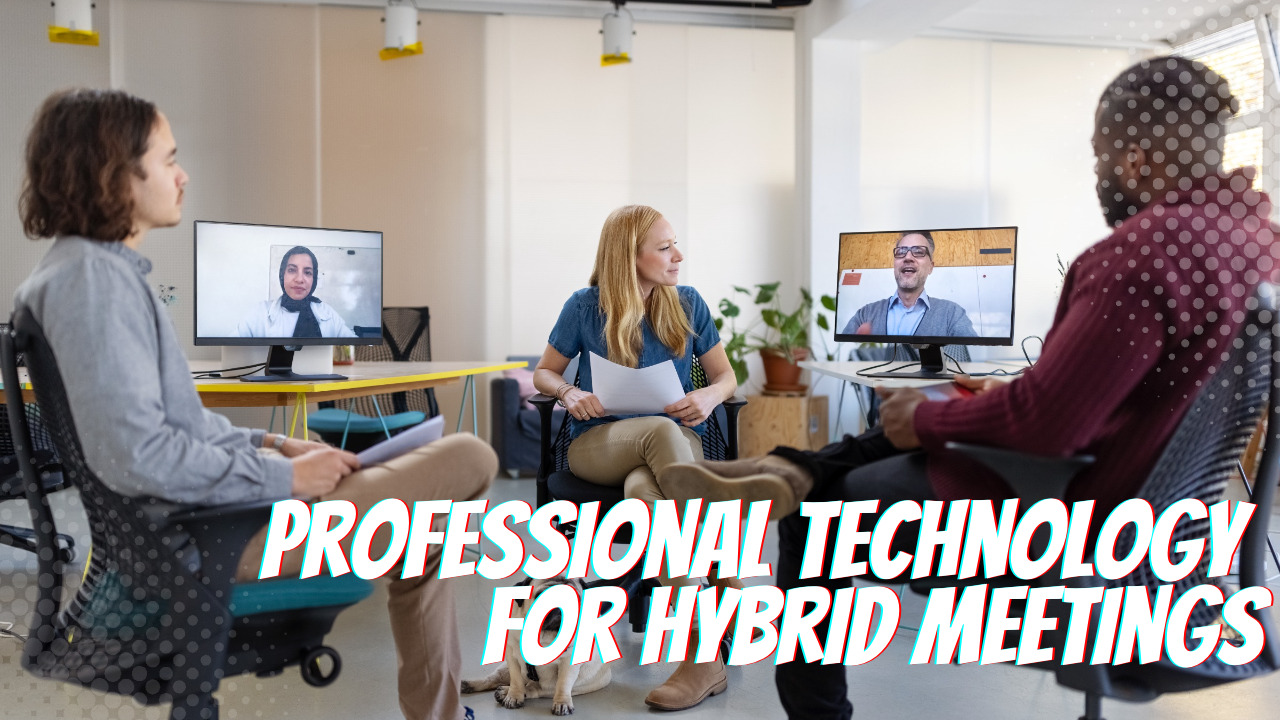The Future of Meetings: Professional Technology for Hybrid Meetings
Key Points
- In 2020, organizations were forced to adopt hybrid meeting experiences, any gatherings that combine physical and virtual participants.
- The rise of remote work and hybrid meetings has been fueled by the changing nature of our culture. We live in an interconnected global society, and our distance from one another is not as much of a limitation as it once was.
- Hybrid meetings have become popular among businesses because they can bridge remote teams and bring people together in a virtual space. However, they can also be challenging to manage without the right professional technology solutions.
- Managing hybrid meetings can be more challenging than managing traditional meetings because there are unique challenges associated with combining physical and virtual participants (e.g., ensuring everyone can hear/see each other, addressing lag time, etc.).
- Organizations that want to ensure successful hybrid meetings must invest in the right professional technology solutions.
In 2020, organizations worldwide were forced to adopt hybrid meeting experiences as the new norm, blurring the lines between physical and virtual collaboration. A hybrid meeting is any gathering of people that combines both physical and virtual participants. This type of meeting allows people to join remotely while still being able to view the same content as those in the room.
Today, hybrid meetings have become popular among businesses of all sizes due to their ability to bridge remote teams and bring people together in a virtual space. When done right, hybrid meetings help us stay connected and productive despite the physical distance between colleagues. However, they can also be challenging to manage without the right professional technology solutions.

How Today’s Culture Is Affecting Hybrid Meetings
The rise of remote work and hybrid meetings has been fueled by the changing nature of our culture. We live in an interconnected global society, and our distance from one another is not as much of a limitation as it once was. With the right technology investments, individuals can easily communicate and collaborate regardless of location.
The importance of hybrid meetings is evident in the fact that more and more organizations are taking advantage of technology to bring together remote and onsite employees. This is especially important for organizations with distributed or global teams, as it allows for greater collaboration, more efficient communication, and increased productivity.
At the same time, hybrid meetings come with their own unique set of challenges.
The Unique Challenges of Hybrid Meetings
Managing hybrid meetings can be more challenging than managing traditional meetings, as there are unique challenges associated with combining physical and virtual participants.
For example, the remote participants may not be able to see or hear the physical participants as well, which can create a disconnect. Additionally, there may be technical issues that arise due to the different technologies being used by participants. Therefore, organizations need to develop a strategy for managing hybrid meetings and ensure that all participants have the same level of access to information and resources.
Our ability to be seen and heard without technical issues is essential for successful hybrid meetings. Inclusion is also important during hybrid meetings as it enables all participants to feel involved, regardless of location. Feelings of being unseen or unheard can lead to frustration among participants, which can hinder productivity and collaboration. Therefore, organizations must strive to provide a consistent experience for all participants and ensure that everyone can fully participate in the meeting.
Organizations must also consider how they can best use the tools to facilitate collaboration and engagement. This includes providing a platform that allows participants to interact and communicate with one another in real time and tools for brainstorming and sharing ideas. Additionally, organizations need to provide participants the necessary resources to effectively participate in a hybrid meeting.
In hybrid work, every person in the room matters, and with the right technology investments, organizations can ensure that no one is left behind. With the right tools in place, organizations can bridge the physical distance between participants, collaborate effectively, and create meaningful connections.
How Better Technology Can Improve the Hybrid Meeting Experience
Today, many teams are leveraging hybrid meeting technology to collaborate in various ways: from audio conferencing and webinars to digital whiteboarding, group chat, and file sharing. The right technology can help make hybrid meetings more efficient and productive, eliminating the need for multiple tools and ensuring that all participants are on the same page.
This is why investing in professional technology for hybrid meetings is essential and can improve the experiences of all participants. For instance, investing in a professional audio solution can help ensure that all participants can hear and be heard. This is especially important when multiple people are speaking simultaneously, as it helps reduce background noise and echo.
The right video-conferencing technology can also make a big difference in hybrid meetings, helping to ensure that all participants can see and be seen. This is essential for effective collaboration. A quality audio and video solution is key for hybrid meetings, but other types of technology can also improve the experience.
For example, digital whiteboarding tools can be used to brainstorm ideas and collaborate on projects in real-time. Group chat tools can facilitate quick and easy communication between participants, while file-sharing tools allow teams to easily share documents.
The Devices You’ll Need for Hybrid Meetings
Transforming the hybrid meeting experience is possible, starting with the right devices. When it comes to professional technology for hybrid meetings, there are a variety of devices available.
To ensure everyone in a hybrid meeting is heard, utilizing microphones and speakers designed for this purpose can make all the difference. Professional headsets engineered with noise cancellation and wideband audio are designed to make sure people can hear each other clearly and effectively, even in a noisy environment. A professional headset can also make remote participants feel like they’re right in the room with the rest of their colleagues.
Projectors are also essential for a successful hybrid meeting. They provide the perfect way to display visuals and materials, such as slides or videos, without passing a device around or having multiple remote participants screen share at once. A projector can also make all the difference in connecting with an audience and ensuring everyone has a good view.
Video conferencing software like Zoom, Skype, and Microsoft Teams provide a platform for hybrid meetings. They allow users to connect from anywhere in the world and share their audio, video, texts, and visuals. They also have features like screen sharing and file sharing, which makes it easier to collaborate with remote participants.
With the right technology, a hybrid meeting can be just as effective as an in-person one. Using professional headsets and projectors, plus video conferencing software, hybrid meetings can be optimized so everyone can fully participate and collaborate without technical issues.
What Is the Value of Investing in Professional Technology for Hybrid Meetings?
The value of investing in professional technology for hybrid meetings is clear: it helps ensure that all participants can see and be seen, hear and be heard, and share ideas in real time. This can create a more engaging experience for all involved and ensures that participants feel connected.
Additionally, investing in the right technology solutions can help teams save time and effort by eliminating the need for multiple tools. This helps ensure that teams can stay on task and focus on the important work that needs to be done. Finally, investing in professional technology for hybrid meetings provides organizations with the necessary resources to ensure that all participants have equal access to information and resources.
Wrap Up
If you take some time to evaluate your meeting technology, you might be surprised to find that there are a variety of ways to improve the hybrid meeting experience. Many technological solutions can help you get the most out of your hybrid meetings, from headset options and video capability to cloud deployment and collaboration tools.
As hybrid meetings continue becoming more commonplace, investing in the right technology is essential. One of the leading tech giants, Microsoft, is on a mission to help organizations create a seamless hybrid meeting experience with solutions like Microsoft Teams and Surface Hub. These tools provide organizations with everything they need to ensure that hybrid meetings are successful and productive.
Getting left behind in the age of video conferencing can be detrimental to your organization’s success. So, taking the time to find the solutions that best fit your needs and budget can help you create a hybrid meeting experience that’s engaging, productive, and equitable.






